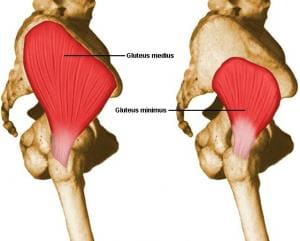Abductor Repair or Reconstruction: when is surgery necessary?
Abductor Repair or Reconstruction is performed when non-operative measures, such as physiotherapy and injection, have failed to significantly improve a patients symptoms.
As discussed on our Hip Abductor Dysfunction page, the pelvis tilts abnormally when the gluteal muscles do not work properly. This puts a lot of strain on the body and although the first port of call for Abductor Dysfunction is physiotherapy (sometimes paired with an injection for pain relief), if symptoms fail to improve then surgery may be necessary.
What does surgery involve?
 Fig. A
Fig. A
Most commonly this is performed as an open procedure, although it can be performed arthroscopically (key-hole surgery). An open procedure involves exposure of the gluteal tendons – gluteus minimus and medius (see Fig. A), debridement (or cleaning) of the tendons is performed followed by debridement of the bone where the tendons are attached. The bone is shaved to stimulate bleeding which in turn aids the healing and health of the bone.
The tendons are repaired in two layers. The gluteus minimus first then the gluteus medius. This is performed with special suture anchors that attach to the bone.
Post-Operative Recovery
Following surgery you will be on crutches for 6 weeks and will be partially weight bearing. This means that you won’t be able to put all of your body weight through the operated leg. A strict hip abductor strengthening programme will be commenced with your physiotherapists.